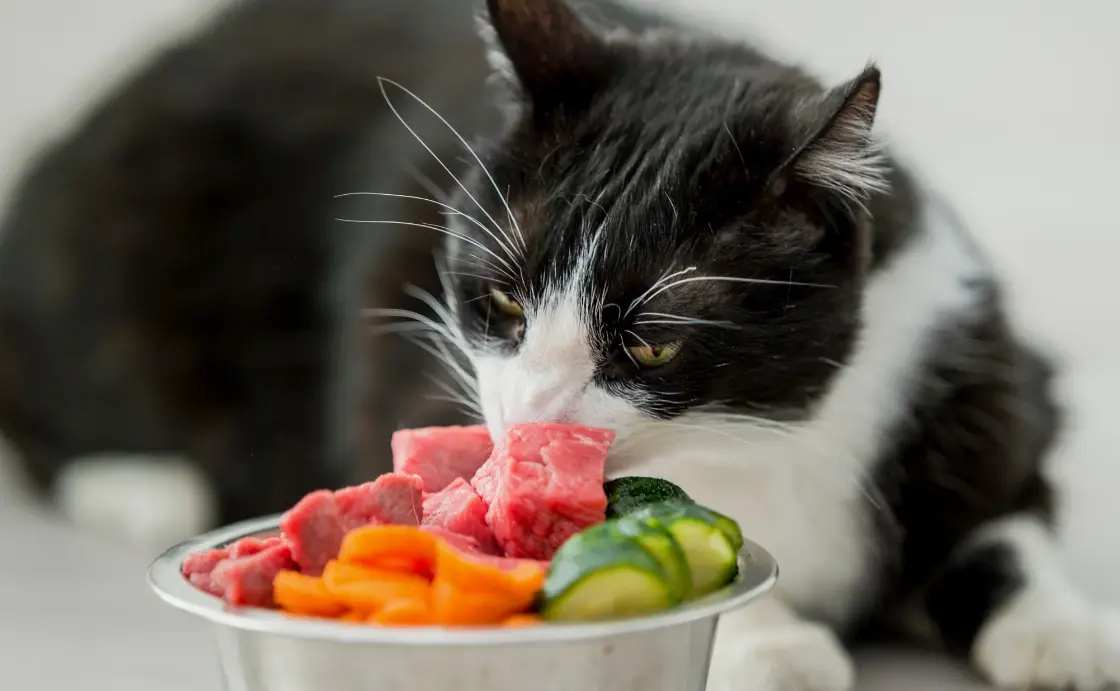In the realm of pet care, the debate over commercial versus homemade cat food has sparked considerable interest. While commercial cat food offers convenience, many pet owners are turning to homemade alternatives for greater control over ingredients and nutrition. Homemade cat food allows for customization to suit individual dietary needs and preferences, ensuring our feline companions receive optimal nutrition for their health and well-being. In this comprehensive guide, we delve into the world of homemade cat food, exploring its benefits, risks, and providing practical tips for crafting wholesome delights for our beloved furry friends.

Understanding Feline Nutritional Needs:
Before diving into the realm of homemade cat food, it’s crucial to understand the unique nutritional needs of our feline companions. Cats are obligate carnivores, meaning they require a diet primarily composed of animal-based proteins to thrive. Unlike omnivorous animals, such as dogs, cats have specific dietary requirements, including essential amino acids like taurine and arginine, which are found abundantly in meat.
Essential Components of Homemade Cat Food:
Crafting homemade cat food involves careful consideration of key nutritional components to ensure a balanced diet. These essential components include:
- Protein: As obligate carnivores, cats rely on high-quality animal protein for essential amino acids. Incorporating sources like lean meats, poultry, and fish into cat food recipes ensures adequate protein intake.
- Fats: Fats are a concentrated source of energy for cats and aid in the absorption of fat-soluble vitamins. Including sources of healthy fats, such as poultry fat or fish oil, helps maintain skin and coat health.
- Carbohydrates: While cats have a limited need for carbohydrates, incorporating small amounts of easily digestible carbohydrates, like cooked grains or vegetables, can provide fiber and additional nutrients.
- Vitamins and Minerals: cat food recipes should include essential vitamins and minerals, either through whole foods or supplements, to meet feline nutritional requirements. Key nutrients include vitamin A, vitamin E, calcium, and phosphorus.
Benefits of Homemade Cat Food:
Opting for homemade cat food offers several benefits for both cats and their owners:
- Ingredient Control: Homemade cat food allows pet owners to control the quality and source of ingredients, ensuring the use of wholesome, natural components free from fillers, additives, and artificial preservatives.
- Customization: cat food recipes can be tailored to meet individual dietary needs and preferences, making it ideal for cats with specific health concerns or food sensitivities.
- Fresher Ingredients: By preparing homemade cat food, pet owners can use fresh, high-quality ingredients, providing superior nutrition compared to processed commercial options.
- Bonding Experience: Involving pet owners in the preparation of cat food fosters a deeper bond with their feline companions, promoting a sense of care and responsibility.
Risks and Considerations:
While homemade cat food offers numerous benefits, it’s essential to be aware of potential risks and considerations:
- Nutritional Imbalance: Formulating homemade cat food requires careful attention to nutritional balance to avoid deficiencies or excesses that can impact feline health. Consultation with a veterinarian or veterinary nutritionist is recommended to ensure recipes meet feline dietary requirements.
- Time and Preparation: Crafting homemade cat food requires time and effort, including meal planning, ingredient sourcing, and preparation. Pet owners should be prepared to dedicate adequate time to ensure consistent and balanced nutrition for their cats.
- Cost: While homemade cat food may offer superior quality ingredients, it can be more expensive than commercial options, especially if using premium or organic ingredients. Pet owners should consider their budgetary constraints when opting for homemade diets.
- Food Safety: Proper handling, storage, and preparation of ingredients are essential to prevent contamination and foodborne illness. Pet owners should follow food safety guidelines to minimize the risk of bacterial contamination in homemade cat food.
Preparing Homemade Cat Food:
When preparing homemade cat food, pet owners should follow these guidelines to ensure nutritional balance and food safety:
- Consultation: Consult with a veterinarian or veterinary nutritionist to develop a homemade cat food recipe tailored to your cat’s specific needs and dietary requirements.
- Ingredient Selection: Choose high-quality, human-grade ingredients, including lean meats, poultry, fish, and fresh vegetables. Avoid ingredients toxic to cats, such as onions, garlic, and certain spices.
- Balance and Variety: Ensure recipes include a balance of protein, fats, carbohydrates, vitamins, and minerals to meet feline nutritional needs. Rotate protein sources and incorporate variety into meals to prevent nutrient deficiencies and boredom.
- Preparation: Cook ingredients thoroughly to eliminate harmful bacteria and improve digestibility. Avoid seasoning or adding unnecessary additives that may be harmful to cats.
- Portion Control: Monitor portion sizes to prevent overfeeding or underfeeding, adjusting quantities based on your cat’s age, weight, activity level, and health status.
- Storage and Serving: Store homemade cat food in airtight containers in the refrigerator or freezer to maintain freshness and prevent spoilage. Thaw frozen portions as needed and serve at room temperature to enhance palatability.
Conclusion:
Homemade cat food offers pet owners an opportunity to provide their feline companions with nutritionally balanced, wholesome meals tailored to their individual needs. By understanding feline nutritional requirements, considering the benefits and risks, and following proper guidelines for preparation and feeding, pet owners can embark on a rewarding journey of crafting homemade delights for their beloved cats. Remember, the key to success lies in careful planning, ingredient selection, and consultation with veterinary professionals to ensure optimal health and well-being for our furry friends.






Leave A Comment